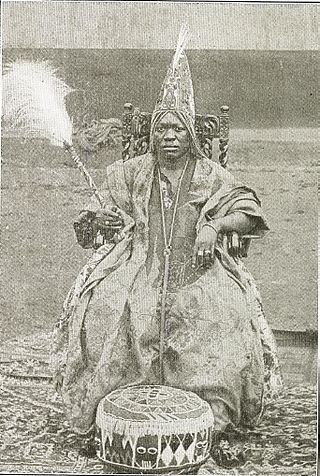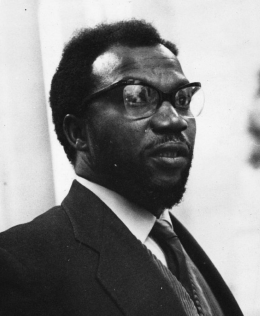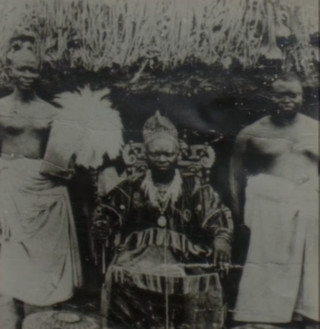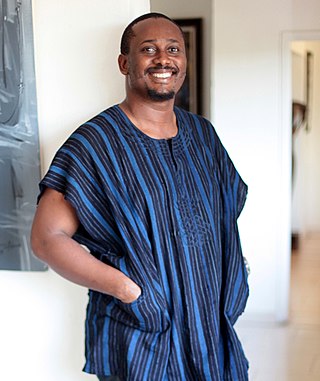Related Research Articles

Oba Sir Titus Martins Adesoji Tadeniawo Aderemi , alias Adesoji Aderemi, (Listen)KCMG, KBE, was a Nigerian political figure and Yoruba traditional ruler as the Ooni (King) of Ife from 1930 until 1980. He served as the governor of Western Region, Nigeria between 1960 and 1962.

Odinigwe Benedict Chukwukadibia Enwonwu MBE, better known as Ben Enwonwu, was a Nigerian painter and sculptor. Arguably the most influential African artist of the 20th century, his pioneering career opened the way for the postcolonial proliferation and increased visibility of modern African art. He was one of the first African artists to win critical acclaim, having exhibited in august exhibition spaces in Europe and the United States and listed in international directories of contemporary art. Since 1950, Enwonwu was celebrated as "Africa's Greatest Artist" by the international media and his fame was used to enlist support for Black Nationalists movement all over the world. The Enwonwu crater on the planet Mercury is named in his honour.
Chief Ògúnwán̄dé "Wán̄dé" Abím̄bọ́lá is a Nigerian academician, a professor of Yoruba language and literature, and a former Vice-Chancellor of the University of Ife. He has also served as the Majority Leader of the Senate of the Federal Republic of Nigeria. Chief Abimbola was installed as Àwísẹ Awo Àgbàyé in 1981 by the Ooni of Ife on the recommendation of a conclave of Babalawos of Yorubaland.
Babajide Christopher Omoworare is a Nigerian politician who was elected Senator for the Osun East constituency of Osun State, Nigeria in April 2011, He ran on the Action Congress of Nigeria (ACN) platform. He was re-elected into the Nigerian senate on 28 March 2015 under the platform of All Progressive Congress (APC) and was succeeded by Francis Adenigba Fadahunsi of the People's Democratic Party (PDP) in June 2019.
Oloye Sir Kofoworola Adekunle "Kofo" Abayomi was a Nigerian ophthalmologist and politician. He was one of the founders of the nationalist Nigerian Youth Movement in 1934 and went on to have a distinguished public service career. His last major public assignment was as chairman of the Lagos Executive Development Board from 1958 until 1966.

Bruce Obomeyoma Onobrakpeya is a Nigerian printmaker, painter and sculptor. He has exhibited at the Tate Modern in London, the National Museum of African Art of the Smithsonian Institution in Washington, D.C. and the Malmö Konsthall in Malmö, Sweden. The National Gallery of Modern Art, Lagos has an exhibit of colourful abstract canvases by Onobrakpeya and his works can be found at the Virtual Museum of Modern Nigerian Art, although no exhibitions were showing as of October 2017.

The Bronze Head from Ife, or Ife Head, is one of eighteen copper alloy sculptures that were unearthed in 1938 at Ife in Nigeria, the religious and former royal centre of the Yoruba people. It is believed to represent a king. It was probably made in the fourteenth-fifteenth century C.E. The realism and sophisticated craftsmanship of the objects challenged Western conceptions of African art. The naturalistic features of the Ife heads are unique and the stylistic similarities of these works "suggest that they were made by an individual artist or in a single workshop."

Ademiluyi Ajagun was the 48th Ooni of Ife, a paramount traditional king of Ile-Ife, the ancestral home of the Yorubas. He was one of the most feared kings and was highly respected in Africa and around the world. He succeeded Ooni Adekola and was succeeded by Ooni Adesoji Aderemi.
Emmanuel Olakunle Filani is a Nigerian educator and artist. His works are closely identified with the school of thought named Onaism; Onaism is an art movement that is based on the fusion of the designs, ornamentation and motifs found in traditional Yoruba carvings and textiles with modern art pieces such as drawings and paintings. Filani is also a lecturer and an administrator – he served as a former provost of the Federal College of Education, Osiele, Abeokuta.
Moyo Okediji is an art historian, painter and artist whose works contains a number of icons and signifiers of the deep aspects of Yoruba culture. He was part of Ona, an art movement at Obafemi Awolowo University.
ErhaborOgievaEmokpae, OON, was a renowned Nigerian sculptor, muralist, graphic artist and painter who is regarded as one of the pioneers of modern arts in Nigeria. Some of his notable works include the a bronze replica of the ivory mask of Queen Idia that was used as the official emblem of the Second World Black and African Festival of Arts and Culture and a popular painting of Queen Amina. He is also responsible for the decorations on the four entrances of the National Arts Theatre, in Lagos.

Yemisi Adedoyin Shyllon is a prince of Ake in Abeokuta, Ogun State, Nigeria. He hails from the Sogbulu and Ogunfayo lineage of the Laarun ruling house of Ake in Egbaland.
Olusegun Adejumo is a Nigerian visual artist, known for his female figure drawings and paintings. He is the director of One Draw Gallery and currently the president of the Guild of Professional Fine Artists Nigeria.

Isaac Emokpae is a Nigerian visual artist, painter, and photographer. His work is defined by duality and is known for its expressionist and surrealist features.
Olajompo Abayomi Akinyeye is a Nigerian professor of history at University of Lagos, Nigeria. His research and teaching interests are in the areas of military history, strategic studies, international relations and diplomacy, comparative foreign policy, and regional integration. He is a widely published author, with several monographs, and dozens of scholarly articles appearing in various edited volumes and high-impact academic journals.
Tunde Odunlade, born 26 November 1954, is a Nigerian artist, actor, and musician known for his Batik art tapestry and designs. He specialises in textile arts, and floatography. He is a member of the Visual Artists Network of the United States of America (VAN) and a frequent participant at the National Conference of Artists, New York. He was a performing actor with the Nigeria Cultural Troupe during Festac. He lives in Ibadan, the southern western part of Nigeria.
Chief Muraina Oyelami is a Nigerian painter and drummer of Yoruba descent. He was among the first generation of artists to come out of the Osogbo School of Art in the 1960s. He was a drummer and actor with the theatre company of Duro Ladipo. He taught traditional music and dance at Obafemi Awolowo University from 1976 to 1987. As a musician, he trained in the dùndún and the Batá drum. He was the chief of his hometown Iragbiji.
Lowa Ajani Anibijuwon Omisore was a Yoruba aristocratic chief in Ife, British Nigeria who founded the town of Ayepe-Olode and founded the Omisore dynasty. He was granted the title of Lowa by Ooni (King) Adelekan Olubuse I of Ife, making him second-in-command to the Ooni. He subsequently served as a regent and a kingmaker in Ife, crowning Ademiluyi Ajagun and Adesoji Aderemi as Ooni. He led and managed the construction of Ife's major road networks under the wishes of Ooni Ajagun and later founded the town of Ayepe-Olode, which he transformed from a desolate jungle that was previously used by animal hunters.
References
- ↑ Odiboh, Freeborn. "The Crisis Of Appropriating Identity For African Art And Artists". Gefame. vol. 2, no. 1. Ann Arbor, MI: MPublishing, University of Michigan Library. Retrieved August 24, 2015.
- ↑ Anonyuo, E. G. (January 01, 1999). Microanalysis of Skokian works of art. Nigerian Skokian Art: a Microanalysis of the Realistic Visual Expression in Contemporary Nigerian Art, 69-107
- 1 2 3 Odiboh, Freeborn. "Creative Reformation of African Art Traditions: The Iconography of Abayomi Barber Art School". African Arts Vol. 42, No. 2, MIT Press. Retrieved August 24, 2015.
- ↑ "ABAYOMI BARBER - a Nigerian "Genius" whose mastery of his Art challenges the British Art History - The Hourglass Gallery". The Hourglass Gallery. 11 December 2014.
- ↑ Anonyuo. P 81-83
- ↑ "I want to enjoy life more, I don't think there's afterlife -- Abayomi Barber, 88." (August 27, 2017). Punch Newspapers: Octogenarian (Nigeria). Retrieved September 29, 2018.
- ↑ "Leading Contemporary Nigerian Artist, Abayomi Barber, Dies at 93". This Day Live. Retrieved 13 January 2022.